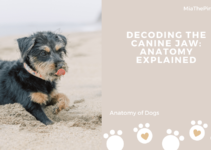Introduction: Exploring the Importance of Understanding Cervical Vertebrae in Dogs
When it comes to our furry companions, understanding their anatomy and how it functions is crucial for their overall well-being. One area of particular importance is the cervical vertebrae, which play a vital role in supporting movement and stability in dogs. In this article, we will delve into the fascinating world of canine cervical vertebrae, exploring their anatomy, function, common issues, diagnostic techniques, and preventive measures for maintaining their health.
Anatomy of Cervical Vertebrae in Dogs: Structure and Composition
The cervical vertebrae are the individual bones that make up the neck region of dogs. These vertebrae are responsible for connecting the skull to the rest of the spinal column and providing support for the head and neck. Composed of seven distinct vertebrae, the canine cervical spine is a complex structure that allows for a wide range of motion, including flexion, extension, and rotation.
Each cervical vertebra consists of a body, a vertebral arch, and various processes. The body serves as the main weight-bearing component, while the vertebral arch protects the spinal cord. Additionally, the processes, such as the spinous and transverse processes, provide attachment points for muscles, ligaments, and tendons, contributing to the overall stability and functionality of the cervical vertebrae.
Function of Cervical Vertebrae in Dogs: Supporting Movement and Stability
The cervical vertebrae in dogs play a crucial role in supporting their everyday movements and maintaining stability. These vertebrae allow dogs to perform essential actions such as turning their heads, tilting, and nodding. Furthermore, the flexibility provided by the cervical vertebrae enables dogs to engage in various activities, including running, jumping, and playing.
Moreover, the cervical vertebrae serve as a protective conduit for the spinal cord, which is responsible for transmitting signals between the brain and the body. The proper alignment and functioning of the cervical vertebrae are essential for ensuring uninterrupted communication and preventing potential neurological issues.
Common Issues and Conditions Affecting Cervical Vertebrae in Dogs
Just like humans, dogs can experience a range of issues and conditions related to their cervical vertebrae. One common problem is intervertebral disc disease, where the discs between the vertebrae degenerate or herniate, causing pain, mobility issues, and potential nerve damage. Other conditions include cervical spondylomyelopathy (Wobbler syndrome), fractures, luxations, and infections.
Recognizing the signs and symptoms of these conditions is crucial for early intervention and appropriate treatment. If you notice your dog experiencing neck pain, stiffness, difficulty in moving their head, or any neurological abnormalities, it is essential to consult a veterinarian promptly for a thorough examination and diagnosis.
Diagnostic Techniques for Assessing Cervical Vertebrae Health in Dogs
Diagnosing cervical vertebrae issues in dogs often requires a combination of clinical evaluation, imaging techniques, and diagnostic procedures. Veterinarians may perform a thorough physical examination, assessing your dog’s posture, range of motion, and neurological function. Additionally, imaging modalities such as X-rays, computed tomography (CT), or magnetic resonance imaging (MRI) can provide detailed insights into the structure and condition of the cervical vertebrae.
In some cases, further diagnostic procedures like myelography or electromyography may be necessary to evaluate nerve function and identify potential abnormalities. The accurate diagnosis of cervical vertebrae issues is crucial for developing an effective treatment plan tailored to your dog’s specific needs.
Maintaining Healthy Cervical Vertebrae in Dogs: Preventive Measures and Treatment Options
Prevention is always better than cure when it comes to maintaining the health of your dog’s cervical vertebrae. Providing a balanced diet, regular exercise, and maintaining a healthy weight can help reduce the risk of developing musculoskeletal issues. Additionally, avoiding excessive jumping or rough play can minimize the strain on the cervical vertebrae.
If your dog does experience cervical vertebrae problems, treatment options may vary depending on the specific condition and severity. Conservative approaches such as rest, pain management, physical therapy, and anti-inflammatory medications are often employed. In more severe cases or when conservative measures fail, surgical interventions may be necessary to alleviate pain, stabilize the vertebrae, or address disc-related issues.
Remember, early detection, prompt veterinary care, and a proactive approach to your dog’s overall health are essential for ensuring the well-being of their cervical vertebrae and, ultimately, their quality of life.
FAQs
1. What is the role of the cervical vertebrae in dogs?
The cervical vertebrae in dogs play a crucial role in supporting their everyday movements and maintaining stability. They allow dogs to turn their heads, tilt, nod, and engage in activities such as running, jumping, and playing.
2. What are some common issues affecting the cervical vertebrae in dogs?
Common issues affecting the cervical vertebrae in dogs include intervertebral disc disease, cervical spondylomyelopathy (Wobbler syndrome), fractures, luxations, and infections. These conditions can cause pain, mobility issues, and potential nerve damage.
3. How are cervical vertebrae issues diagnosed in dogs?
Diagnosing cervical vertebrae issues in dogs often requires a combination of clinical evaluation, imaging techniques, and diagnostic procedures. Veterinarians may perform a physical examination, assess posture, range of motion, and neurological function. Imaging modalities such as X-rays, CT scans, or MRI can provide detailed insights into the structure and condition of the cervical vertebrae.
4. What are some preventive measures for maintaining healthy cervical vertebrae in dogs?
To maintain the health of your dog’s cervical vertebrae, it is important to provide a balanced diet, regular exercise, and maintain a healthy weight. Avoiding excessive jumping or rough play can also minimize strain on the cervical vertebrae.
5. What are the treatment options for cervical vertebrae issues in dogs?
Treatment options for cervical vertebrae issues in dogs may vary depending on the specific condition and severity. Conservative approaches such as rest, pain management, physical therapy, and anti-inflammatory medications are often used. In more severe cases or when conservative measures fail, surgical interventions may be necessary to alleviate pain, stabilize the vertebrae, or address disc-related issues.


